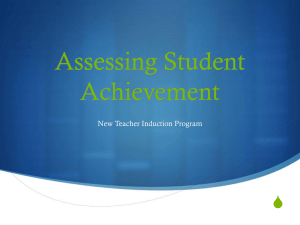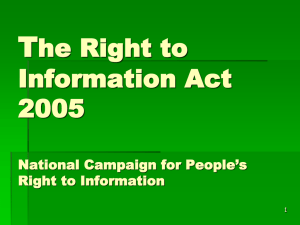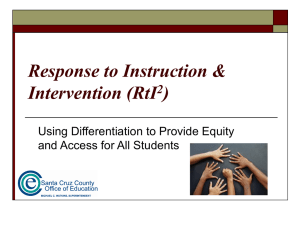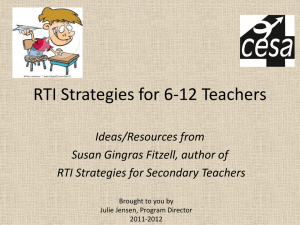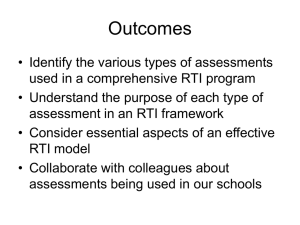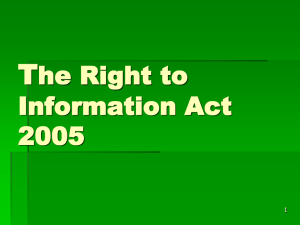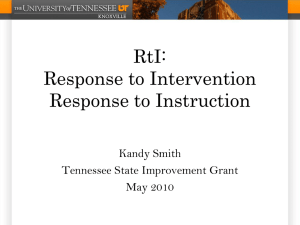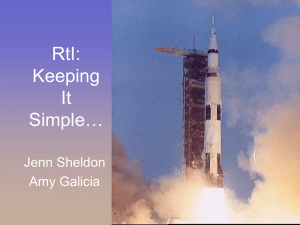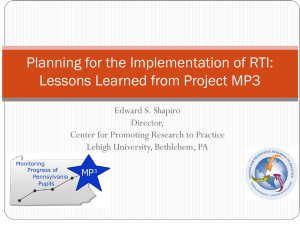Chris` Powerpoint Presentation
advertisement
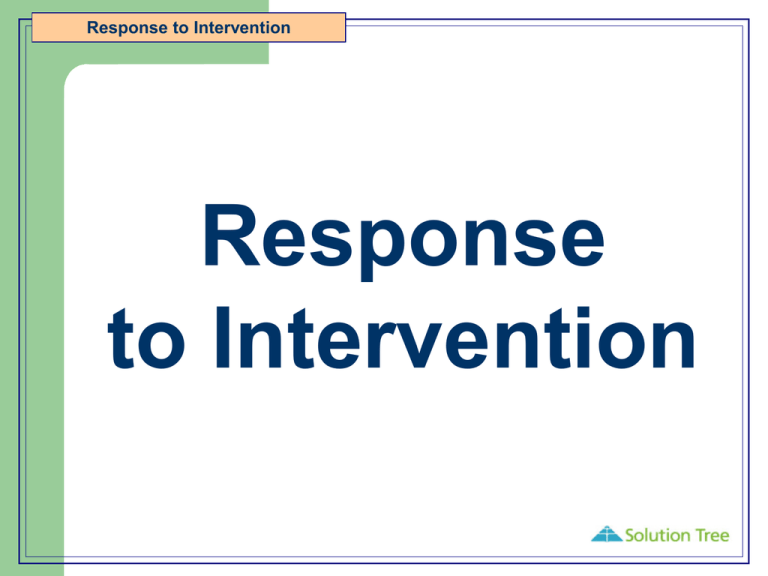
Response to Intervention Response to Intervention Response to Intervention Objectives Participants will Gain a deeper knowledge of Response to Intervention so that they can immediately apply its principles Response to Intervention Agenda The Four Questions of RTI The Four Cs of RTI Essential Standards Chart Cycle of RTI Building a System of Supports – RTI Rubric Decision Making in RTI – – Decision Making Within Tiers of Support Progress Monitoring – Decision Flowchart RTI Resources Response to Intervention RTI and PLC in Good Spirit RTI has everything in common with PLC Various, more individualized levels of intervention for struggling students Balancing accountability and RTI RTI cannot be a mandate – it will look different in each school RTI can work with our current level of resources. Response to Intervention RTI and PLC in Good Spirit RTI in a classroom, within a team, and across the school. The Who, What, and When of RTI RTI ≠ Lots of paperwork Small group instruction must be a part of every classroom RTI – Loose v. Tight How of we measure our effectiveness? Response to Intervention Where Did RTI Come From? PL 94-142 IQ and the Discrepancy Model Over-representation President’s Commission on Excellence in Special Education IDEIA 2004 “RTI is a general education initiative” Response to Intervention RTI Response to Intervention RTI Response to Intervention Response to Intervention About which students do we have concerns? In what areas do we have concerns? – – – Academics Social behaviors Academic behaviors What are we currently doing to support students and meet the student needs? What supports will we be providing in the future? Has the student responded to the instruction and interventions we have been providing? – Four Questions of RTI Response to Intervention 4 Cs of RTI Collective Responsibility Concentrated Instruction Convergent Assessment Certain Access Response to Intervention Collective Responsibility A shared belief that the primary responsibility of each member of the organization is to ensure high levels of learning for every child. Thinking is guided by the question… Why are we here? Response to Intervention Collective Responsibility Commit to collective responsibility for ALL students' learning – – Openly discuss expectations, biases, and experiences Research schools that have been successful with students like those you serve Foster a collaborative culture – – – – Build trust Start a professional book club Identify and celebrate the strengths of all staff Acknowledge your areas for growth Response to Intervention Collective Responsibility Open your doors to colleagues, share best practice and ideas, and be willing to learn – – Schedule regular lesson studies or co-plan/co-teach opportunities Arrange for roving substitutes so that teachers can watch and learn from teachers Create weekly team time during which teachers focus on student learning – – Bank minutes to build time into the day Create and commit to team norms that allow for open, focused dialogue Response to Intervention Concentrated Instruction A systematic process of identifying essential knowledge and skills that all students must master to learn at high levels and determining the specific learning needs for each child needed to get there. Thinking is guided by the question… Where do we need to go? Response to Intervention Concentrated Instruction Focus on essential learning – – Identify and unpack the most essential standards and learning targets for your grade level or content area Essential Standards Chart Ensure that your core instruction is sound – – – Systemically, collaboratively analyze your craft so that instruction constantly improves Differentiate for all learners (content, process, product) Build daily, small group, targeted support into each lesson Response to Intervention Concentrated Instruction Identify and explicitly teach social behaviors – – – Teach and expect students to self-monitor http://pbis.org Concentrating, Screening, and Planning for Behavioral Supports Identify and explicitly teach academic behaviors – – – Teach and expect students to self-regulate Self-Regulatory Assessment Tool Self-Regulatory Problem Solving Tool Response to Intervention Convergent Assessment An ongoing process of collectively analyzing targeted evidence to determine the specific learning needs of each child and the effectiveness of the instruction the child receives in meeting these needs. Thinking is guided by the question… Where are we now? Response to Intervention Convergent Assessment Efficiently screen to identify students at-risk Create assessments to measure student mastery of essential skills Enthusiastically monitor student progress – Identify assessments that can be use to validly and reliable monitor student progress – http://easycbm.com Develop a systematic plan to monitor the progress of students at-risk regularly Convergent Assessment – Diagnosing Reading Difficulties Reading Domains, Skills, Assessments Response to Intervention Convergent Assessment Assess for social behaviors – – – – Analysis of the Function of Behavior SSRS BDF http://swis.org Assess for academic behaviors – – Self-Regulatory Assessment Tool Self-Regulatory Problem Solving Tool Response to Intervention Convergent Assessment Schedule regular meetings during which teacher teams (weekly) and teacher teams with administrators (monthly) analyze: – – – – About which students do we have concerns? In what areas do we have concerns? What are we doing to support students? Have students responded to the instruction and interventions we have been providing? Response to Intervention Certain Access A systematic process that guarantees every student will receive the time and support needed to learn at high levels. Thinking is guided by the question… How do we get every child there? Response to Intervention Certain Access When – scheduling and programming – – – – Schedule time for interventions first Protect collaborative time Protect reading, writing, and mathematics Challenge assumptions Who – interventionists – – Inventory human resources Use staff creatively Response to Intervention Certain Access What – identify high quality, expertlyimplemented interventions for the at-risk learners at your school – – Social behaviors – http://fcrr.org http://interventioncentral.com Strategies for Improving Behavior Checklist Academic behaviors – – Self-Regulatory Assessment Tool Self-Regulatory Problem Solving Tool Response to Intervention Certain Access Eagerly communicate needs and progress to all stakeholders – Develop a system for communicating the progress of students at-risk to the student, parents, and all staff who work with the student Do whatever it takes to ensure every student learns with intensity, a sense of urgency, and the expectation that learning WILL occur – – – Celebrate and highlight successes Study them so they can be replicated Monitor every aspect of the RTI system to ensure that it is faithfully and energetically implemented. Response to Intervention Scenario RTI is a verb Response to Intervention Tiers Tier 1 – Core – – Classroom teacher or collaborative team Within the instructional block Tiers 2 and 3 – More – – – – Increasing the frequency of the support Increasing the duration of the support Decreasing the student-teacher ratio on the intervention group Increasing the specificity of the support Response to Intervention Essential Standards Chart Standard/Description – Example/Rigor – What is the essential standard to be learned? Describe in student-friendly vocabulary. What does proficient student work look like? Provide an example and/or description. Prior Skills Needed – What prior knowledge, skills, and/or vocabulary is/are needed for a student to master this standard? Response to Intervention Essential Standards Chart Common Assessment – When Taught? – What assessment(s) will be used to measure student mastery? When will this standard be taught? Enrichment – What will we do when students have learned the essential standard(s)? Cycle of RTI Select and unwrap essential student learning outcomes and indicators and develop a unit assessment plan Analyze summative assessment results, identify students in need of supplemental interventions Introduce learning targets to students. Begin core instruction. Analyze formative assessment results, provide mid-unit interventions, continue and/or complete core instruction Response to Intervention Building a System of Supports RTI Rubric 4 – Consistent and Effective 3 – Fairly Consistent and Generally Effective 2 – Inconsistent and Occasionally Effective 1 – Not Present or Observable Collective Responsibility Concentrated Instruction Convergent Assessment Certain Access Response to Intervention Decision Making in RTI Decision Making Within Tiers of Support 4 – Consistent and Effective 3 – Fairly Consistent and Generally Effective 2 – Inconsistent and Occasionally Effective 1 – Not Present or Observable Decision Making in RTI Decision Making Within Tiers of Support Decision Making in RTI Decision Making Within Tiers of Support Decision Making in RTI Decision Making Within Tiers of Support Response to Intervention Decision Making in RTI Progress Monitoring – Decision Flowchart What is the rate of improvement? Meeting targets? “Consider…” Response to Intervention Decision Making in RTI Progress Monitoring – Decision Flowchart What is the rate of improvement? Meeting targets? “Consider…” Response to Intervention Thank You! Pyramid Response to Intervention Chris Weber cweber_teacher@yahoo.com @Chi_educate Christopher Weber https://public.me.com/chrisaweber Response to Intervention Thank You! Response to Intervention
